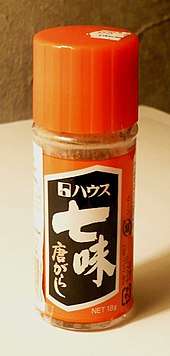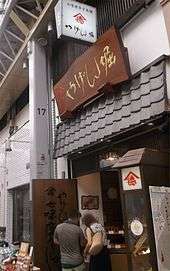Shichimi
Shichi-mi tōgarashi (七味唐辛子, seven-flavor chili pepper), also known as nana-iro tōgarashi (七色唐辛子, seven-color chili pepper)[1][2] or simply shichimi, is a common Japanese spice mixture containing seven ingredients.[3]
Shichimi tōgarashi. | |
| Alternative names | Nana-iro tōgarashi |
|---|---|
| Type | Spice mixture |
| Place of origin | Japan |
| Invented | 17th century |

A typical blend may contain:
- coarsely ground red chili pepper (the main ingredient)
- ground sanshō ("Japanese pepper")
- roasted orange peel (Chenpi)
- black sesame seed
- white sesame seed
- hemp seed[4]
- ground ginger[3]
- nori or aonori (seaweed)
- poppy seed
Some recipes may substitute or supplement these with yuzu peel, rapeseed or shiso.
Shichimi is distinguished from ichi-mi tōgarashi (一味唐辛子, one-flavor chili pepper), which is simply ground red chili pepper.
History

It dates back at least to the 17th century, when it was produced by herb dealers in Edo,[3] current day Tokyo, and sometimes it is referred to as Yagenbori (薬研堀, from the name of the original place of production). Most shichimi sold today come from one of three kinds, sold near temples: Yagenbori (やげん堀) sold near Sensō-ji, Shichimiya (七味家) sold near Kiyomizu-dera, and Yawataya Isogorō (八幡屋磯五郎) sold near Zenkō-ji.
Use
It is often consumed with soups and on noodles and gyūdon. Some rice products such as rice cakes, agemochi and roasted rice crackers also use it for seasoning.
See also
- List of condiments

References
- Nihon Kokugo Daijiten (dictionary).
- Shin Meikai kokugo jiten (dictionary).
- Zeldes, Leah A. (2010-04-14). "Eat this! Shichimi togarashi, zesty Japanese seasoning". Dining Chicago. Chicago's Restaurant & Entertainment Guide. Retrieved 2010-05-22.
- Hongo, Jun (Dec 11, 2007). "Hemp OK as rope, not as dope". The Japan Times. Retrieved 2010-05-22.